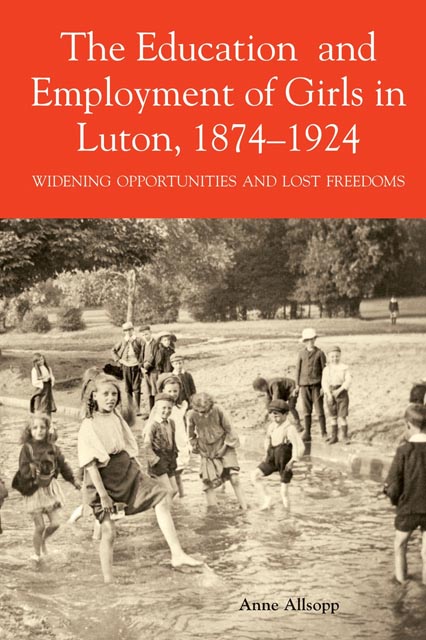Book contents
- Frontmatter
- Contents
- List of Illustrations
- List of Tables
- Dedication
- Acknowledgements
- Abbreviations
- Introduction
- Chapter One Luton: Scientiae et labori detur
- Chapter Two Further Perspectives Concerning Employment Patterns for Women
- Chapter Three Sunday Schools
- Chapter Four Education in the Time of the School Board
- Chapter Five Teaching: An Alternative Occupation
- Chapter Six Teacher Training and the Education of Students Aged Over Fourteen Under Bedfordshire County Council
- Chapter Seven Elementary Education 1903–1924
- Chapter Eight Rural Schools
- Chapter Nine Learning and Living
- Chapter Ten Secondary Education for Girls
- Conclusion
- Appendix
- Bibliography
- Index
Chapter One - Luton: Scientiae et labori detur
Published online by Cambridge University Press: 03 August 2023
- Frontmatter
- Contents
- List of Illustrations
- List of Tables
- Dedication
- Acknowledgements
- Abbreviations
- Introduction
- Chapter One Luton: Scientiae et labori detur
- Chapter Two Further Perspectives Concerning Employment Patterns for Women
- Chapter Three Sunday Schools
- Chapter Four Education in the Time of the School Board
- Chapter Five Teaching: An Alternative Occupation
- Chapter Six Teacher Training and the Education of Students Aged Over Fourteen Under Bedfordshire County Council
- Chapter Seven Elementary Education 1903–1924
- Chapter Eight Rural Schools
- Chapter Nine Learning and Living
- Chapter Ten Secondary Education for Girls
- Conclusion
- Appendix
- Bibliography
- Index
Summary
This chapter looks at the character and identity of Luton and notes how the lives of its women changed significantly between 1874 and 1924, particularly with regard to education and employment. To understand the development of education and the widening of employment prospects for girls in Luton it is necessary to look at the background of the town and the surrounding area in the context of the straw hat industry. Luton is in the south of Bedfordshire, about twenty miles from Bedford and by 1874 it had a larger population than any other town in the county. This study does not look at Bedford in detail, but comparisons need to be made between the two towns. Similarities would be hard to find; Luton has been described as a town built on straw whereas Bedford prospered as the result of the endowments of William Harpur. ‘Relations between the industrial town and the rural county, dominated by Bedford, were rarely good. Indeed, Luton had long since ceased to feel any common bond with Bedfordshire, whose values, politics and economy were so very different to its own.’
Previous histories of Luton have included the hamlets of East and West Hyde, Leagrave, Limbury-cum-Biscot and Stopsley, and this study has followed the same pattern. From an educational point of view this adds interest, as the hamlets were administered at different times by the Luton and Bedfordshire education authorities. Table 1 provides details of the population growth of Luton, the hamlets and Bedford. The figures for the civil parish of Luton from 1841 to 1891 include the township of Luton and the hamlets of East and West Hyde, Leagrave, Limbury and Stopsley. East and West Hyde were conjoined as the civil parish of Hyde in 1895. Leagrave, Limbury and part of Stopsley were absorbed into Luton Borough in 1928, and the remainder of Stopsley followed in 1933.
The figures in Table 1 indicate that the population of Hyde remained comparatively static, Stopsley grew slowly and steadily. Leagrave's numbers doubled in twenty years but the population of Limbury-cum-Biscot quadrupled in that time. This growth is reflected in the amount of school provision. Hyde did not need a new school, although one was built to replace the old building after the Board took control in 1898, and Stopsley was given new buildings in 1909 and 1912.
- Type
- Chapter
- Information
- The Education and Employment of Girls in Luton, 1874-1924Widening Opportunities and Lost Freedoms, pp. 1 - 32Publisher: Boydell & BrewerFirst published in: 2023



